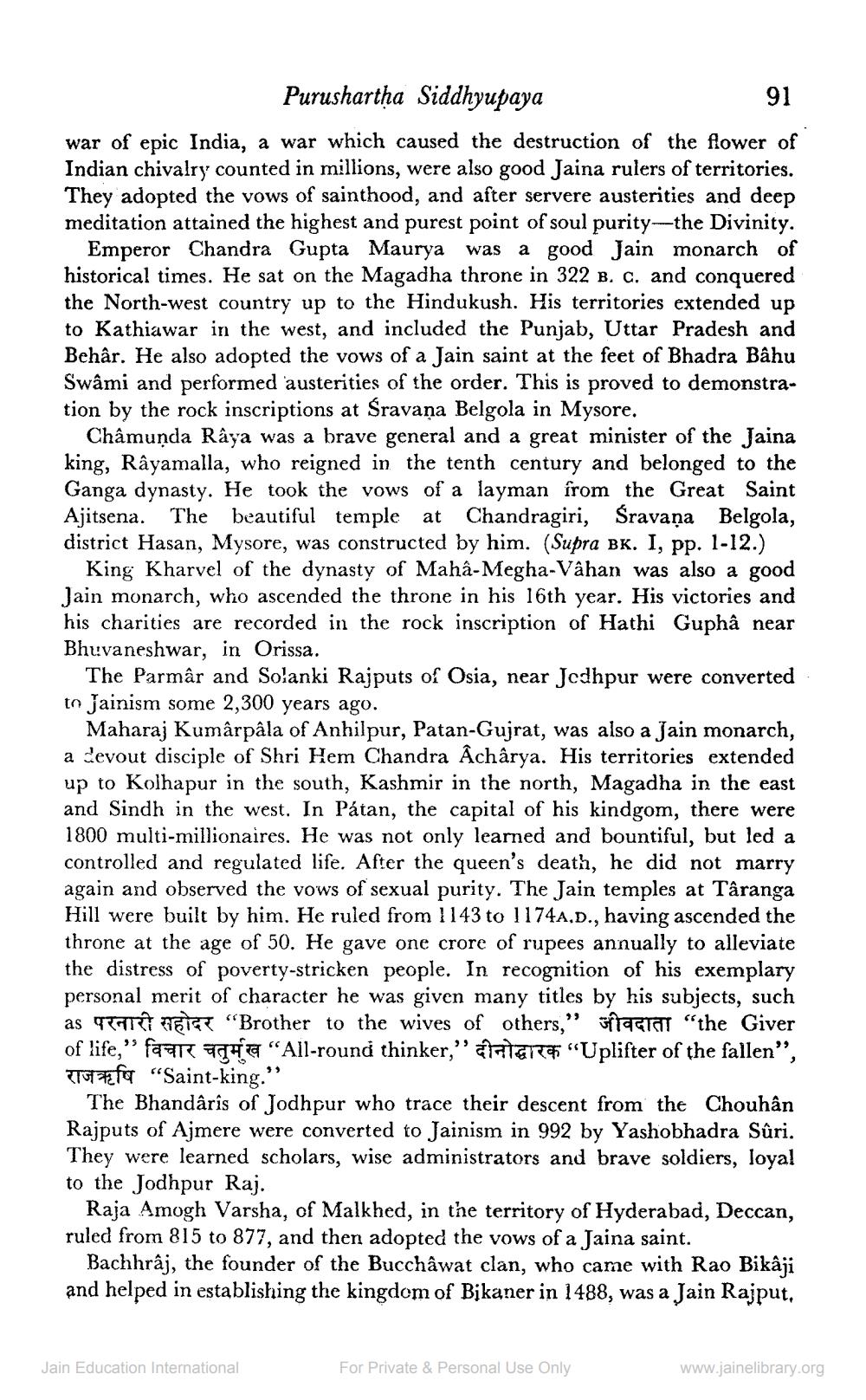________________
91
Purushartha Siddhyupaya war of epic India, a war which caused the destruction of the flower of Indian chivalry counted in millions, were also good Jaina rulers of territories. They adopted the vows of sainthood, and after servere austerities and deep meditation attained the highest and purest point of soul purity-the Divinity.
Emperor Chandra Gupta Maurya was a good Jain monarch of historical times. He sat on the Magadha throne in 322 B. C. and conquered the North-west country up to the Hindukush. His territories extended up to Kathiawar in the west, and included the Punjab, Uttar Pradesh and Behâr. He also adopted the vows of a Jain saint at the feet of Bhadra Bâhu Swami and performed austerities of the order. This is proved to demonstration by the rock inscriptions at Śravaņa Belgola in Mysore.
Châmunda Râya was a brave general and a great minister of the Jaina king, Râyamalla, who reigned in the tenth century and belonged to the Ganga dynasty. He took the vows of a layman from the Great Saint Ajitsena. The beautiful temple at Chandragiri, Śravana Belgola, district Hasan, Mysore, was constructed by him. (Supra Bk. I, pp. 1-12.)
King Kharvel of the dynasty of Mahâ-Megha-Vâhan was also a good Jain monarch, who ascended the throne in his 16th year. His victories and his charities are recorded in the rock inscription of Hathi Guphâ near Bhuvaneshwar, in Orissa.
The Parmar and Solanki Rajputs of Osia, near Jodhpur were converted In Jainism some 2,300 years ago.
Maharaj Kumârpâla of Anhilpur, Patan-Gujrat, was also a Jain monarch, a devout disciple of Shri Hem Chandra Acharya. His territories extended up to Kolhapur in the south, Kashmir in the north, Magadha in the east and Sindh in the west. In Pátan, the capital of his kindgom, there were 1800 multi-millionaires. He was not only learned and bountiful, but led a controlled and regulated life. After the queen's death, he did not marry again and observed the vows of sexual purity. The Jain temples at Târanga Hill were built by him. He ruled from 1143 to 1174A.D., having ascended the throne at the age of 50. He gave one crore of rupees annually to alleviate the distress of poverty-stricken people. In recognition of his exemplary personal merit of character he was given many titles by his subjects, such as परनारी सहोदर "Brother to the wives of others," जीवदाता “the Giver of life," faar a "All-round thinker," hara "Uplifter of the fallen", 7672fQ “Saint-king."
The Bhandârîs of Jodhpur who trace their descent from the Chouhân Rajputs of Ajmere were converted to Jainism in 992 by Yashobhadra Sûri. They were learned scholars, wise administrators and brave soldiers, loyal to the Jodhpur Raj
Raja Amogh Varsha, of Malkhed, in the territory of Hyderabad, Deccan, ruled from 815 to 877, and then adopted the vows of a Jaina saint.
Bachhraj, the founder of the Bucchâwat clan, who came with Rao Bikâji and helped in establishing the kingdom of Bikaner in 1488, was a Jain Rajput,
Jain Education International
For Private & Personal Use Only
www.jainelibrary.org




